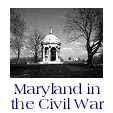

After Confederate forces fired on Fort Sumter, several thousand Marylanders slipped across the Potomac to join the Confederate Army. The vast majority enlisted into regiments from Virginia or the Carolinas. However, six companies of Marylanders formed at Harpers Ferry into the Maryland Battalion.
Virginia tried to convince the Marylanders to join a Virginia regiment, but Captain Bradley T. Johnson, commander of Company A., refused. It was Johnson's contention, as well as many of his men, that while Maryland had not seceeded from the Union, she had failed to do so because of the tryanny of the U.S.; and with Maryland now under the tyrant's heel, unable to assist the Confederacy, she should be represented in the Confederate Army.
The Conderate Army assigned Arnold Elzey, an experienced, career officer from Maryland to command the 1st MD. His executive officer was Marylander George Hume Steuart. Steuart would later earn the nickname "Maryland Steuart" to distinguish him from JEB Stuart.
As career officers, both Elzey and Steuart were strict disciplinarians. They were harsh, but never to the point of cruelty. They drilled them until they dropped from exhaustion, and punished them for the slightest infraction. In some units, where officers were elected from the ranks, there might have been desention and insurrection; but the men seemed to realize that Elzey and Steuart were only looking out for them in the long run.
The Maryland Battalion officially became the 1st Maryland Infantry Regiment on June 16, 1861. Two additional companies joined the regiment in Winchester on June 25th.
When General Johnston evacuated Harper's Ferry in June, the 1st Md. was detailed to assist in the destruction of the arsenal. In performing this duty they saved some 17,000 gun stocks from a fire, which they sent to North Carolina to show their gratitute for that state's endeavors to outfit the regiment.
Johnston moved west into the great Valley of Virginia to block General Patterson's advance there, while General Beauregard settled in at Manassas. As the first major confrontation of the war neared, Johnston swiftly moved his men to Manassas. But many did not arrive until the battle was in full swing. The 1st Md. had been grouped with the 13th Virginia, 10th Virginia and 3rd Tennessee to form the 4th Brigade under General E. Kirby Smith. Smith's men were among the last to arrive at Manassas. They quickly marched to the sound of the guns, coming up on the Confederate left near Chin Ridge. Smith was shot from his horse and Elzey assumed temporary command. He brought his men on line, slightly obique to the left of the main battle line, and to his amazement, on the flank of the Federal position. His men moved forward to the edge of a wood undetected and opened fire. The Federals responded and a bloody fire fight began. In the midst of smoke and confusion, Elzey ordered his men to charge over an open field. The Confederates crashed into the Federal line and the fight degenerated to hand to hand fighting. The Federals pulled back and Elzey pushed his men through a thick stand of woods. Unknown to Elzey, General Early had come on line on the left as well and had acted in the same manner as Elzey. Their rushes had cracked the thinned Federal flank. Within minutes the Federal line was reeling north then east toward the bridge and thier escape. President Jefferson Davis, and Generals Johnston and Beauregard rode up to Elzey. Beauregard exclaimed "General Elzey, you are the Blucher of the day!"
Elzey was promoted Brigade Commander, Colonel Steuart took command of the 1st Maryland and Major Bradley Johnson became his second in command. After Manassas the 1st Maryland moved to Fairfax Court House and later Fairfax Station where it was detached to Colonel JEB Stuart's command. Here Steuart honed the regiment with daily drill and strict discipline. Here also the regiment often skirmished with Federal patrols, and participated in the capture of Mason's Hill.
The regiment wintered at Centerville. In April it marched back to the Rappahannock, and there assigned to General Ewell's command. Ewell was soon dispatched to join Jackson in the Valley, and arrived at Jackson's camp on the evening of April 30th. The next morning Ewell and his men found Jackson's camp abandoned, Old Man Jack had stormed off to kick General Milroy in the pants at McDowell.
When Jackson returned, the combined commands marched to Luray. There the term of enlistment for Company C. expired. Also at Luray the first attempt to establish the "Maryland Line," was made. The Confederacy made several attempts over the course of the war to unite all of Maryland's rebels under one command. Steuart was promoted to General, and the regiment was detached from Elzey's Brigade. Once there was a break in the fighting, the 1st Maryland was to "return to the Valley District, as it might facilitate the organiization by being in the Valley. T.J. Jackson, Major-General."
Five days later the 1st Md., at the rear of Jackson's column, was ordered to the front to spear head the attack on Front Royal, garrisoned by the 1st Maryland Infantry, U.S.A. But newly promoted Colonel Johnson had a small problem. Seeing Company C. muster out of service had made many of his men home sick and they had mutineed. Johnson had a number of them under guard when the order came down. An eloquent speech by Johnson convinced his mutineers to take up their arms, and the regiment threw itself against the Federal Marylanders at Front Royal.
Maryland newspapers were ripe with stories about the horrible atrocities the rebel Marylanders inflicted on their brothers in battle. But they were all false. After the battle the Marylanders gained Jackson's permission to tend to the wounded Union Marylanders and guard the Maryland prisoners. The regiment even provided a detachment to guard these men on their march South to a holding site. Not until Colonel Kinley of the 1st Md. U.S.A. was paroled and returned to Baltimore, were the newspapers set right about what really happened at Front Royal.
After Front Royal Jackson took off after Banks. On May 25th the 1st Md. was among the troops who captured Winchester, and several days later occuppied Bolivar Heights above Harper's Ferry. But Jackson soon had to withdrawl as Fremont and Shields began a move to intercept him. During the withdrawl the 1st Maryland served with the cavalry as a rear guard. Here they became closely affiliated with Turner Asbhy, Jackson's cavalry commander. On the morning of June 6th, near Harrisonburg, Ashby became intangled in a fight with the famed "Pennsylvania Bucktail Sharpshooters" who had come across part of the Confederate encampment. In the engagement Ashby was killed, and the regimental colors of the 1st Maryland was forever changed: "In commemoration of the gallant conduct of the First Maryland Regiment on the 6th day of June, when led by Colonel Bradley T. Johnson they drove back with loss the "Pennsylvania Bucktail Rifles," in the engagement near Harrisonburg, Rockingham County, Virginia, authority is given to have one of the captured "Bucktails" appened to the color-staff of the First Maryland Regimetn. By order of Major-General Ewell."
During the Battle of Cross Keys on the 9th, the 1st Md. held Ewell's extreme left, and successfully repulsed three Federal attacks. The following day Jackson fought the Battle of Port Republic, which the 1st Md. was spared, then pulled back up the Valley to Weyer's Cave. It's ranks seriously depleted, the regiment was ordered to Staunton. There, companies H. & I. mustered out of service, and a new company from Richmond arrived and was designated as the new Company C. Before Johnson could complete his reorganization, Jackson was ordered to Richmond. Formantion of the Maryland Line would again have to wait.
On June 26th the 1st Md. was at the head of Jackson's column near Gaines Mill when they encountered Federal troops. The regiment kept the Federal infantry at bay until the Baltimore Light Artillery could be brought up to dislodge the Federal troops. The following day Jackson's command encountered General Fitz John Porter's troops north of the Chickahominy. Being unattached to any brigade at this time the 1st Maryland was held in reserve. But the Marylanders chafed to get into the fight. Without orders, Johnson brought the regiment across a field, soon over taking Lawton's brigade of Georgians. The Georgians were ordered to lie down and the Marylanders marched over them to cheers from the prostate Georgians. The Marylanders soon came under heavy fire and according to W.W. Goldsborough, Johnson's adjudant, the little regimetn became unsteady. Johnson ordered his men to halt "On the colors, dress!" Then while under fire he ordered his men "Order arms! Shoulder arms! Present arms! Shoulder arms! Forward! March!" "The effect was magical. The men recovered themselves and the formation of the regiment was restored. But all this had its effect in another direction, for the brave men coming to the rear had observed it, and rallied on the regiment's ranks." When Hampton's Legion planted it's colors to Johnson's left, he found himself in command of a sizeable force. A force soon supported by fellow Marylander, General Charles S. Winder, and the 1st Virginia Brigade. The line moved forward and captured five Federal guns, numerous prisoners and small arms. Winder commended Johnson in his offical report for his actions."
The following morning the regiment moved with JEB Stuart to destroy the tracks of the York River Railroad at Dispatch Station. On the 30th they crossed the Chickahominy with Ewell, and on the 1st of July arrived at a place called Malvern Hill. They were held in reserve, but still suffered from the hellish artillery barrage of the Federal cannon. That night they were detached with a portion of J.R. Jones Brigade, and Lawton's Brigade to protect General Winder's extreme right flank. The following morning they engaged Federal cavalry in a short skirmish before the cavalry retired.
With Richmond safe, Jackson moved north. It's term of service due to expire, the 1st Md. moved with Jackson only as far as Gordonsville. From there they could hear Jackson's guns dueling with Pope at Cedar Run. Co. A. was assigned to escourt Jackson's prisoners to Richmond, and was mustered out of service shortly after it's arrival there. On August 17th the remainder of the regiment was mustered out of service at Gordonsville.
The men of the 1st Maryland voted to have the flag escourted to North Carolina and presented to Mrs. Bradley Johnson. She had fled Maryland with them to Harper's Ferry. She had endured camp life with them. She had been exposed to dangers with them. She had been their nurse and their friend. And it had been she who gone to North Carolina and returned with 500 Mississippi long rifles and 10,000 rounds of ammunition, and enough money to buy for them uniforms, and tents and cooking utensils and all the camp equipment that an infantry regiment might need.
Bradley Johnson and his staff offered their services to General Jackson. Johnson was given temporary command of General J.R. Jones brigade, Jones being on sick leave. At Manassas, Johnson's Brigade held the ground to the left of the famed "dump." This area was hit by numerous Federal attacks, but Johnson and his Virginias held on with a great tenacity, and even captured a Federal field piece.
When Jackson moved into Maryland, Johnson served as the Army of Northern Virginia's Porvost Marshall. Lee then sent Johnson to Richmond with dispatches for President Davis. Johnson, a lawyer was then placed on a court martial board and was stuck doing this type of work for the next year. But he would return to the field and the new 1st Maryland Infantry, and later the 1st Maryland Cavalry.
What of the common soldiers? At first most of them went to Richmond to enjoy their first free time in months. But many soon became bored. But they couldn't go home. Crossing the Potomac, they had basicly attached themselves to the Confederacy for the duration of the war. Some joined the artillery. Most joined the cavalry. But a few hung around Richmond with hopes of forming a new Maryland Infantry Regiment. They succeeded beyond their wildest hopes. The new 1st Maryland, which was later re-designated the 2nd Maryland Infantry in order to distinguish it from the original regiment, would have a history as glorious, if not more so then its' ancestor.

| 
| 
| 
| 
|